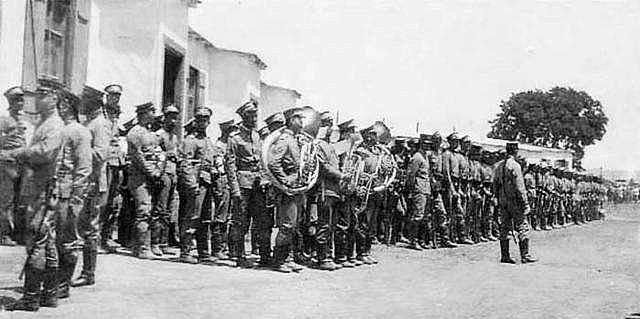What is history: it is the echo of the past to the future, the reflection of the future on the past. - Hugo
In 1900, the Qing Dynasty was invaded by the Eight-Power Alliance and was forced to sign the Treaty of Xinugu with the great powers, completely degenerating into a semi-colonial and semi-feudal society. In order to save its precarious rule, the Qing Dynasty was forced to implement the "New Deal", which essentially restored some of the measures of the 1898 Restoration and Reform Law. Among the many measures of the "New Deal", the formation of a modernized new army is the most important one.

As early as 1895 (the twenty-first year of Guangxu), after the Sino-Japanese Sino-Japanese War, the Qing government sent Hu Yandi to train troops at Tianjin Xiaozhan and form the "Dingwu Army". Subsequently, Yuan Shikai was reassigned to train the new army. Yuan Shikai, modeled on the German and Japanese army establishment and code regulations, expanded and reorganized the Dingwu Army, from more than 4,000 people to 7,300 people, and named it the "New Army", that is, the Beiyang New Army.
In 1901 (the twenty-seventh year of Qing Guangxu), after Yuan Shikai became the governor of Beiyang and the minister of Beiyang, he reorganized the former Beiyang New Army. In 1902, the original "Beiyang New Army" was expanded into the "Beiyang Standing Army", and at the same time, the construction of relevant troop organization and structure was further improved. With the efforts of Yuan Shikai and others, the new-style army gradually faded the color of the ancient army and gradually took on the elements of the modern army.
The selection criteria for officers and men of the Forces nouvelles are relatively strict, with most officers serving as military students studying abroad and graduates of various military academies in the country, while soldiers adopt a recruitment system, with clear stipulations on age, physique and cultural level. The tactics, organization, and system of the Forces nouvelles are all modeled in Western countries. Therefore, compared with most other Qing troops, the new army is obviously an armed force with relatively strict military discipline and relatively high morale.
In addition, while updating training methods and weapons and equipment, the Forces nouvelles have also made improvements to their uniforms. The Training Department officially formulated the new military uniform style including dress, regular clothes, epaulettes, hat emblems, collar badges, etc., and at this point, the traditional military uniform of the Chinese feudal dynasty, which had been used for hundreds of years, officially withdrew from the historical stage, and since then the military uniforms of the Qing Army have been completely westernized. At the same time, in order to be in line with the mainstream of the world, many officers and men of the New Army cut off their braids in advance.
Housekeeping is an indispensable part of military life, and modern militaries, known for their standardization, pay more attention to this. As a "good war division" in the West, the New Army at the end of the Qing Dynasty did not spare no effort in the internal affairs of officers and men, and the regulations in the New Army stipulated that soldiers "must maintain a clean appearance." Compared with other Qing army units at the end of the Qing Dynasty, the internal affairs of the new army can be regarded as neat enough.
Elite troops were often given priority in obtaining supplies, and the new army was equipped with a large number of advanced weapons such as The Mauser rifle, the Maxim heavy machine gun, the Krupp artillery, the Armstrong gun, the Grusson artillery, and the Qing Dynasty was also the first country in Asia to be equipped with seven-shot guns and thirteen-shot guns. The machine gun team in the photo is using a European heavy machine gun.
At the turn of the 19th and 20th centuries, the use of hot air balloons in the West for military reconnaissance was popular, and the new army from the Western army obviously learned this. Pictured is a reconnaissance unit of the Forces nouvelles, equipped with reconnaissance balloons imported from Europe. Compared with traditional methods of investigation, this kind of investigation is obviously more efficient.
However, the New Army was still based on the decadent feudal system of the Qing Dynasty, and the decaying system could not provide sufficient motivation and protection for the New Army. In addition, the establishment of the new army not only did not save the Qing Dynasty from demise, but became a catalyst for accelerating the collapse of the Qing Dynasty: in the Xinhai Revolution, many revolutionaries were officers and soldiers of the New Army, and Yuan Shikai, who held the power of the New Army, also used the strength of his forces to force the Qing Emperor to abdicate.